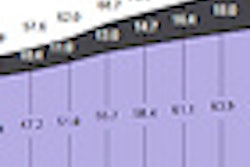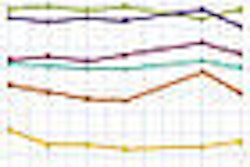The growth of advanced diagnostic imaging in Medicare patients slowed to single-digit rates starting in 2006, a trend that has extended to private payors, according to a study from the August issue of Health Affairs, published online July 25. The study confirms other recent research documenting imaging's slowdown.
Whether the slowdown indicates that patients are getting less unnecessary imaging remains unclear. But it's obvious that the softer market has decreased radiologists' salaries and has undermined the position of radiology groups in negotiations with hospitals, according to authors David Lee, PhD, general manager and head of health economics at GE Healthcare, and Dr. Frank Levy of Harvard Medical School.
"We were interested in understanding whether the slowdown in imaging use others had found persisted in recent years, and whether it carried into the private sector," Lee told AuntMinnie.com. "And we had other questions, such as what caused the decrease in imaging use, what effect that decrease has on the radiology market, and whether our study has bigger policy implications."
Single-digit growth rates
Using claims file data and interviews with healthcare professionals, Lee and Levy found that the growth rate of imaging use -- specifically, CT and MRI -- among both Medicare beneficiaries and those insured outside of the Medicare system slowed to 1% to 3% per year through 2009, after more than a decade of annual growth rates of approximately 6% (Health Affairs, July 25, 2012). The study is the first to investigate the imaging use slowdown in both Medicare and private-payor populations, Lee said.
Related story: JAMA study finds that imaging use is growing even at HMO
At the peak of the imaging boom, from 2000 to 2005, use of CT in the Medicare system grew at an annual rate of 14.3%. Utilization growth declined each year after 2005, from 7.1% in 2006 to 1.4% in 2009; use of MRI in Medicare slowed from a 14% annual growth rate during the period to an average of 2.6% per year between 2006 and 2009, Lee and Levy wrote.
Why the slowdown? The reasons are varied, according to the authors, with some trends applicable among Medicare patients while others apply to both Medicare and privately insured patients:
- Prior authorization: Lee and Levy cited one estimate that claimed that at least half of all commercially insured people are now covered by a prior authorization program run by a radiology benefits manager (RBM).
- Increased cost sharing: More insurers and employers have modified procedures so that many commercially insured people have higher co-pays.
- Reimbursement reductions sparked by the Deficit Reduction Act (DRA) of 2005: Before 2005, Medicare paid more in some cases for imaging studies acquired in a freestanding imaging center or a physicians' office than for similar studies taken in a hospital outpatient facility. The DRA mandated that beginning in 2007, no study should be reimbursed at more than the hospital outpatient rate.
- Fear of radiation exposure: Imaging utilization growth may have slowed because physicians and patients were increasingly warned of the dangers of radiation exposure from CT, PET, and nuclear medicine tests.
"There's no single factor that seems to be responsible, but rather a combination of effects," Lee told AuntMinnie.com. "If you think of [imaging use] as a dial, and the dial was at neutral in 2005, [all these factors] turned the dial back a notch."
Softer market
Along with slowing utilization came a softer employment market for radiologists, according to Lee and Levy. Between 1998 and 2005, median annual salaries for diagnostic radiologists grew from $272,000 to $426,000; during those years, radiologists benefited from rapidly growing utilization, and the tight labor market allowed radiology groups to negotiate with hospitals in the group's favor. And technology, specifically digital imaging and associated PACS workstations, gave radiologists the ability to read more studies.
But by 2007, demand for imaging studies was slowing, while radiologists' capacity to read exams continued to increase. Hospitals got more aggressive with their existing radiology groups, at times requiring them to relinquish the right to read all imaging studies. This made it easier to attract cardiologists and urologists to read their own imaging exams, and teleradiology firms began to compete with groups for hospital contracts.
The result is that radiologists' bargaining power has taken a hit, according to Lee.
"What used to be a seller's market has turned into a buyer's market," Lee told AuntMinnie.com. "Hospitals have more market power, there's downward pressure on salaries, and it's harder for radiologists to find jobs. In the past, radiologists could run a hospital department, but now hospitals are dictating terms to the radiologists."
Related story: 'One-size-fits-all' imaging cuts do more harm than good
It still remains unclear whether the slowdown in imaging's growth rate has been bad for patients -- that is, restricting their access to necessary procedures -- or whether decreased use has been concentrated among imaging studies of uncertain medical value. This includes procedures that do not necessarily lead to concrete, positive patient outcomes, such as MRI of the lumbar spine, MRIs of upper- and lower-extremity joints, or CT of the pelvis, according to the authors.
"We do not presume that the slowdown of MRIs of the spine and extremity joints and of CTs of the pelvis all represent imaging studies of limited value," they wrote. "Rather, we present these examples to illustrate that some part of the slowdown in the growth of imaging utilization involves imaging studies of potentially limited value and that the slowdown's impact on patient welfare is deserving of further detailed study."
In other words, it's hard to quantify the value of diagnostic tests because their benefit depends on effects that may not be observed for a while, Lee told AuntMinnie.com.
"We looked at where imaging has slowed the most, by procedure, to assess whether there was correlation in areas where imaging slowed the most and whether the exam's value was proven or established," he said. "We concluded that there may be some kind of association between the two."



















